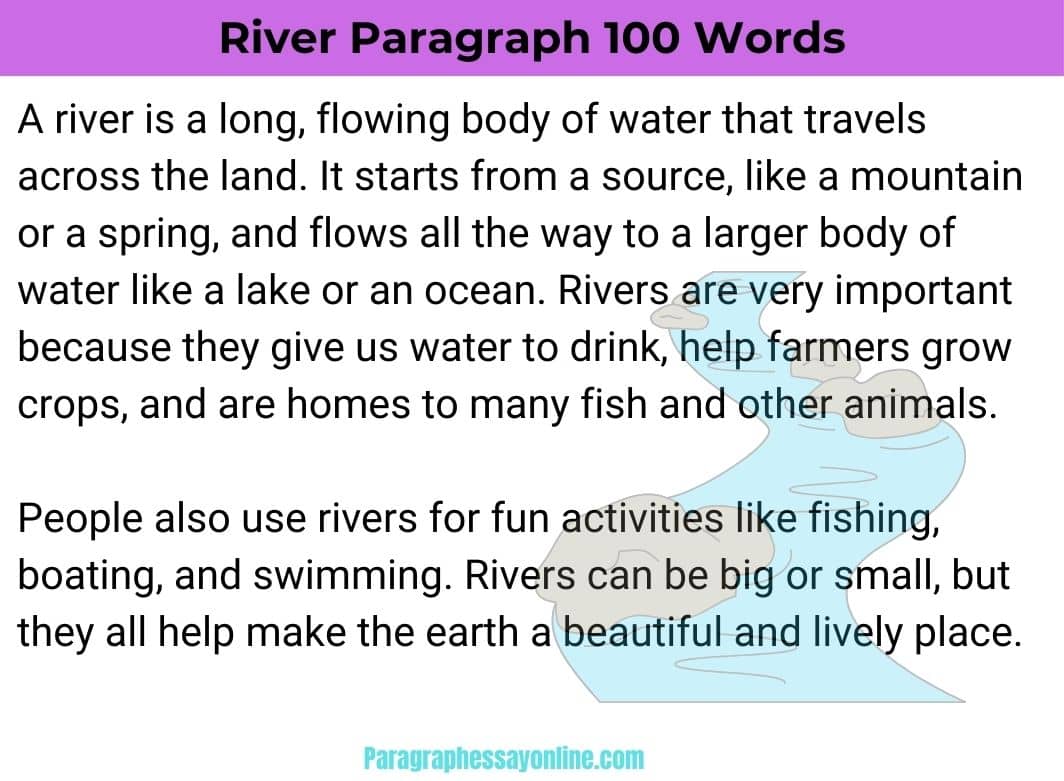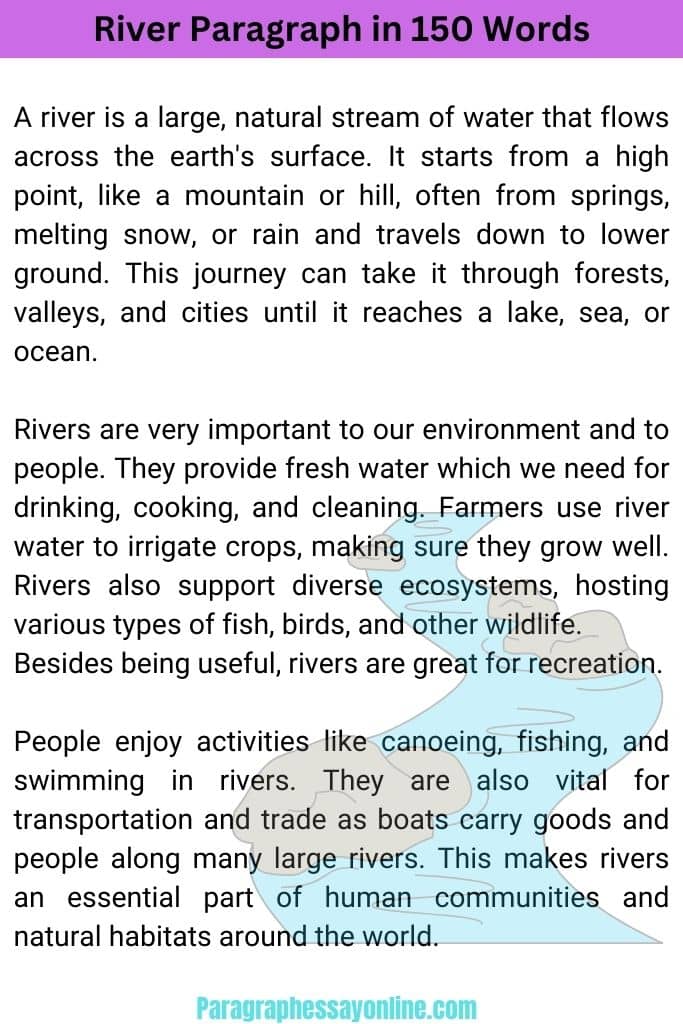River Paragraph
River Paragraph Long and Short (100-500 words)
A river paragraph is a concise, yet descriptive, piece of writing that captures the essence of a river. It typically includes details about the river’s appearance, movement, and surrounding environment, painting a vivid picture for the reader.
Paragraph On River 100 Words For 1, 2, 3 Students
A river is a long, flowing body of water that travels across the land. It starts from a source, like a mountain or a spring, and flows all the way to a larger body of water like a lake or an ocean. Rivers are very important because they give us water to drink, help farmers grow crops, and are homes to many fish and other animals.
People also use rivers for fun activities like fishing, boating, and swimming. Rivers can be big or small, but they all help make the earth a beautiful and lively place.

River Paragraph in 150 Words For 4 & 5 Students
A river is a large, natural stream of water that flows across the earth’s surface. It starts from a high point, like a mountain or hill, often from springs, melting snow, or rain and travels down to lower ground. This journey can take it through forests, valleys, and cities until it reaches a lake, sea, or ocean.
Rivers are very important to our environment and to people. They provide fresh water which we need for drinking, cooking, and cleaning. Farmers use river water to irrigate crops, making sure they grow well. Rivers also support diverse ecosystems, hosting various types of fish, birds, and other wildlife.
Besides being useful, rivers are great for recreation. People enjoy activities like canoeing, fishing, and swimming in rivers. They are also vital for transportation and trade as boats carry goods and people along many large rivers. This makes rivers an essential part of human communities and natural habitats around the world.

Paragraph On River in 200 Words For 6, 7, and 8 Students
Rivers, flowing bodies of water, originate from higher altitudes like mountains or hills, often starting as springs or melting glaciers. They journey across the land, gaining more water from tributaries, rain, and other sources, and can dramatically shape the landscapes they traverse through processes such as erosion and sediment deposition.
Ecologically, rivers are vital. They serve as habitats for diverse species, from tiny insects to large mammals and birds. The biodiversity in river ecosystems is immense, with some species entirely dependent on river environments. For humans, rivers are indispensable for agriculture, as they provide necessary irrigation that supports vast areas of cropland. Additionally, rivers supply water for drinking, sanitation, and industrial activities.
Culturally and historically, rivers have been pivotal. They have been the cradle of numerous civilizations, such as those in the Nile, Indus, and Euphrates river valleys, offering resources, transportation routes, and strategic advantages. Today, rivers continue to be central to many cultural traditions and local economies.
Preserving river health is essential. This includes maintaining water quality and flow, protecting surrounding habitats, and managing human impacts such as pollution and water extraction. Sustainable management practices are crucial to ensure that rivers continue to sustain their ecological, economic, and cultural functions for future generations.
River Paragraph in 250 Words For 8,9,10 Students
Rivers are powerful natural systems essential to both the environment and human civilizations. Originating from springs, glaciers, or rainwater gathering in streams, they flow across varied landscapes, shaping the earth’s surface through erosion and deposition. These waterways are crucial for biodiversity, serving as habitats for numerous species and facilitating nutrient cycling and ecological connectivity.
Ecologically, rivers support complex food webs, from algae and plankton to fish and mammals, and play a critical role in the life cycles of many species, including migratory fish that spawn in freshwater. They also act as natural corridors that connect different ecological regions, enhancing biodiversity.
Many of the world’s great cities are located along rivers, using the water for domestic needs, transportation, and as a means to dispose of waste. Rivers also feature prominently in culture and religion, symbolizing life and renewal.
For humans, rivers have been indispensable. They provide water for drinking, agriculture, and industry, and have historically been vital for transportation and trade. Many of the world’s ancient civilizations developed along rivers, utilizing their resources for sustenance and growth.
However, rivers face significant threats from pollution, overuse, and alterations like damming, which disrupt their natural flow and affect both water quality and wildlife. The health of rivers is crucial not only for the environment but also for human economies and communities.
Efforts to protect and restore rivers are essential. These include reducing pollution, managing sustainable water use, and restoring natural flows and habitats. Education and community engagement are also vital, as they raise awareness and promote actions that contribute to the health and longevity of these vital ecosystems.
River Paragraph 300 Words For 9, 10, 11, 12 Students
Rivers are dynamic natural systems that play multiple critical roles in both ecological and human contexts. Originating from varied sources like snowmelt, rain runoff, or underground springs in mountainous areas, rivers flow across diverse terrains, gathering water from additional tributaries. This journey affects their speed, volume, and the geography of the lands they traverse, contributing significantly to landscape shaping through erosion and sediment transport.
Ecologically, rivers are essential for water cycling and serve as habitats for a vast array of flora and fauna. They facilitate complex ecosystem functions, such as nutrient cycling and providing spawning grounds for fish, which are crucial for maintaining biodiversity. The riparian zones along rivers are particularly rich in species and are critical for ecological connectivity in fragmented landscapes.
For human societies, rivers have always been crucial. They provide freshwater necessary for domestic use, agriculture, and industry, supporting human livelihoods and economic activities. Rivers also offer avenues for transportation and have historically enabled the growth and sustainability of civilizations by providing routes for exploration, trade, and cultural exchange.
However, rivers face numerous threats from human activity, including pollution, overfishing, damming, and diversion for irrigation and industrial use. These activities can lead to degraded water quality, disrupted flow patterns, and loss of biological diversity, undermining the rivers’ health and their ability to provide essential services.
Conservation efforts are therefore paramount. They involve regulating activities that impact river health, restoring degraded river systems, and implementing sustainable water management practices. Education and awareness programs are also crucial to fostering a stewardship ethic among communities to protect these vital natural resources.
Understanding the multifaceted roles rivers play in sustaining both ecological balance and human cultures is essential for their preservation. As such, comprehensive strategies that address the environmental, social, and economic dimensions of river ecosystems are needed to ensure their health and vitality for generations to come.
Paragraph On River in 500 Words For 9, 10, 11, and 12 Students
Rivers, vital components of the Earth’s hydrological cycle, are dynamic natural systems that commence from various sources such as melting snow in mountains, springs, or direct precipitation accumulating in streams. As they flow, rivers carve their paths through landscapes, shaping the earth through erosion and sediment deposition. These bodies of water not only sculpt the physical environment but also create rich habitats that support diverse ecosystems.
Rivers begin as small streams and gradually grow as they collect more water from rainfall, other streams, or underground sources, becoming powerful enough to shape the terrain they traverse. They carry nutrients, sediment, and organic material, which are vital for the ecological health of the watercourses and their surrounding areas. This material supports a complex food web, starting from microscopic organisms and ending with top predators such as birds and mammals.
The ecological significance of rivers extends beyond merely providing habitat. They are crucial for nutrient cycling and are integral to the life cycles of many aquatic and terrestrial species. Many fish, for instance, rely on rivers for part of their breeding cycles, migrating upstream to spawn. Rivers also act as natural corridors, enabling the migration of species and thus maintaining biodiversity across vast regions.
Humans have depended on rivers since ancient times for water, food, and as transportation routes. Civilizations have historically flourished along rivers due to the fertile land made rich by river sediments, ideal for agriculture. Today, rivers continue to be essential for irrigation, drinking water, and as energy sources through hydroelectric power. Furthermore, they hold significant socio-cultural value, featuring in folklore, religion, and art across various cultures.
However, the health of river systems is increasingly threatened by human activities. Pollution from industrial discharges, agricultural runoff, and urban waste has severely impacted water quality. Physical alterations such as dam construction and water diversion for irrigation and urban use disrupt the natural flow, affecting the life cycles of aquatic species and reducing riverine biodiversity.
They provide habitats for wildlife and are integral to water cycles, supporting plant and animal life along their banks. For humans, rivers are invaluable sources of water for drinking, agriculture, and industry. They also offer opportunities for transportation and recreation, such as boating and fishing.
Addressing these challenges requires comprehensive management strategies that balance human needs with environmental sustainability. This includes enforcing stricter pollution controls, restoring natural river flows, and protecting critical habitats. Education and community involvement are also crucial, as they promote a deeper understanding and commitment to river conservation.
Preserving rivers is essential not only for ecological balance but also for human well-being. They are not just water sources but are lifelines for biodiversity and human societies. Ensuring the health of river ecosystems is imperative for sustaining the natural heritage and ecological integrity of our planet. Conservation efforts must be holistic, involving multiple stakeholders and disciplines, to develop sustainable solutions that will safeguard river systems for future generations.
Most Important Paragraph:
| Favourite Sportsman Paragraph. |
| Mango Paragraph. |
| Likes And Dislikes Paragraph. |
| Water Pollution Paragraph. |
| My Pet Animal Paragraph. |
Frequently Asked Questions on River Paragraph
Q: What should a river paragraph include?
A river paragraph should describe the river’s appearance, flow, surroundings, and any notable features.
Q: How can I make my river paragraph more engaging?
Use vivid imagery, sensory details, and descriptive language to bring the river to life for the reader.
Q: Why are river paragraphs important in writing?
River paragraphs help evoke emotions, create imagery, and set the scene in a narrative or descriptive piece.
Q: Can a river paragraph be fictional?
Yes, a river paragraph can be based on a real river or entirely imagined, allowing for creative expression in writing.
